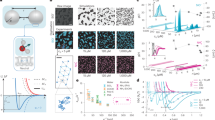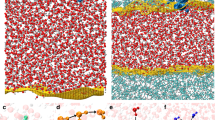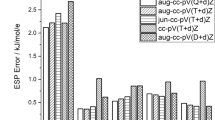Abstract
The attractive interaction between organic nonpolar molecules, such as hydrocarbons, in water is unusually strong. This ‘hydrophobic interaction’1 is responsible for the very low solubility of hydrophobic molecules in water, and has a central role in micelle formation, biological membrane structure, and in determining the conformations of proteins2,3. It was once believed that because the interaction is so strong there is a ‘hydrophobic bond’ associated with it2,4; but it is now recognized that the interaction involves the configurational rearrangement of water molecules as two hydrophobic species come together5–9 and is therefore of longer range than a typical covalent bond. However, there has been no experimental information available concerning the distance dependence and effective range of this interaction. From measurements of the total force as a function of distance between two hydrophobic surfaces immersed in aqueous electrolyte solutions we have determined accurately the attractive component due to the hydrophobic interaction and found that the hydrophobic interaction has the same range as, but is about an order of magnitude stronger than, the van der Waals-dispersion force; and that in the range 0–10 nm it decays exponentially with distance with a decay length of ∼1 nm. The results can be roughly extrapolated to molecular interactions and show that the interaction free energy of two hydrophobic solute molecules of radius R (nm) in water at 21 °C is approximately given by ΔGH = −40R kJ mol−1, which is in agreement with previous estimates. However, the hydrophobic interaction is not due to a ‘hydrophobic bond’, and its long-range nature has obvious implications for the mechanism and rates of folding as well as the equilibrium conformations of proteins and other macromolecules.
This is a preview of subscription content, access via your institution
Access options
Subscribe to this journal
Receive 51 print issues and online access
$199.00 per year
only $3.90 per issue
Buy this article
- Purchase on Springer Link
- Instant access to full article PDF
Prices may be subject to local taxes which are calculated during checkout
Similar content being viewed by others
References
Franks, F. Water: A Comprehensive Treatise Vol. 4 (ed. Franks, F.) Ch. 1 (Plenum, New York, 1973).
Kauzmann, W. Adv. Protein Chem. 14, 1–63 (1959).
Tanford, C. The Hydrophobic Effect 2nd edn (Wiley, New York, 1980).
Nemethy, G. & Scheraga, H. A. J. phys. Chem. 66, 1773–1789 (1962).
Ben-Naim, A., Wilf, J. & Yaacobi, M. J. phys. Chem. 77, 95–102 (1973).
Dashevsky, V. G. & Sarkisov, G. N. Molec. Phys. 27, 1271–1290 (1974).
Marcelja, S., Mitchell, D. J., Ninham, B. W. & Sculley, M. J. JCS Faraday Trans. II 73, 630–648 (1977).
Chan, D. Y. C., Mitchell, D. J., Ninham, B. W. & Pailthorpe, B. A. Molec. Phys. 35, 1669–1679 (1978).
Rossky, P. J. & Friedman, H. L. J. phys. Chem. 84, 587–589 (1980).
Israelachvili, J. N. & Adams, G. E. Nature 262, 774–776 (1976); JCS Faraday Trans. I 74, 975–1001 (1978).
Pashley, R. M. J. Colloid Interface Sci. 80, 153–162 (1981).
Pashley, R. M. & Israelachvili, J. N. Colloids & Surfaces 2, 169–187 (1981).
Horn, R. G. & Israelachvili, J. N. J. chem. Phys. 75, 1400–1411 (1981).
Israelachvili, J. N. Phil. Mag. A43, 753–770 (1981).
Verwey, E. J. W. & Overbeek, J. Th. G. Theory of the Stability of Lyophobic Colloids (Elsevier, New York, 1947).
Chan, D. Y. C., Pashley, R. M. & White, L. R. J. Colloid Interface Sci. 77, 283–285 (1980).
Evans, D. F., Tominaga, T. & Davis, H. T. J. chem. Phys. 74, 1298–1305 (1981).
Dymond, J. H. J. phys. Chem. 85, 3291–3294 (1981).
Harris, K. R. & Trappeniers, N. J. Physica 104 A, 262–280 (1980).
Tucker, E. E., Lane, E. H. & Christian, S. D. J. Solut. Chem. 10, 1–20 (1981).
Parsegian, V. A., Fuller, N. & Rand, R. P. Proc. natn. Acad. Sci. U.S.A. 76, 2750–2754 (1979).
Ohshima, H., Inoko, Y. & Mitsui, T. J. Colloid Interface Sci. 86, 57–72 (1982).
Author information
Authors and Affiliations
Rights and permissions
About this article
Cite this article
Israelachvili, J., Pashley, R. The hydrophobic interaction is long range, decaying exponentially with distance. Nature 300, 341–342 (1982). https://doi.org/10.1038/300341a0
Received:
Accepted:
Issue Date:
DOI: https://doi.org/10.1038/300341a0
This article is cited by
-
Advancements in nanoscale delivery systems: optimizing intermolecular interactions for superior drug encapsulation and precision release
Drug Delivery and Translational Research (2024)
-
An overview of surface forces and the DLVO theory
ChemTexts (2023)
-
Assessing the Mobilization of Trapped Mass of Emulsions Flowing in an Idealized Pore Using the Lattice Boltzmann Method
Transport in Porous Media (2023)
-
Evaluation of interaction forces between hydrophobic surfaces in surfactant solutions by atomic force microscopy
Colloid and Polymer Science (2023)
-
Aggregating structure in coal water slurry studied by eDLVO theory and fractal dimension
Frontiers in Energy (2023)
Comments
By submitting a comment you agree to abide by our Terms and Community Guidelines. If you find something abusive or that does not comply with our terms or guidelines please flag it as inappropriate.



